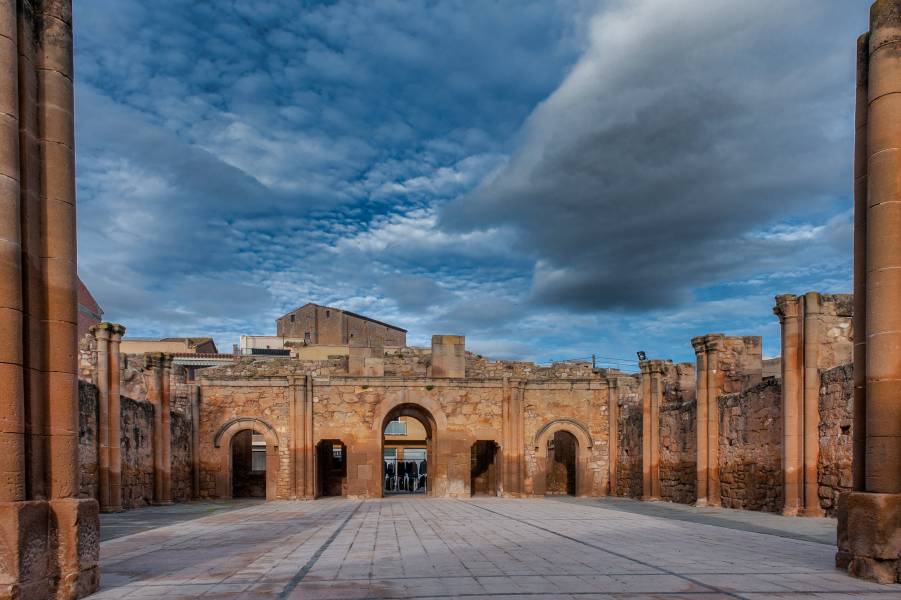After the town was repopulated during the reconquest,
Ramon de Cervera granted the territory to the
Cartuixa d'Escaladei , to whom it belonged, with some interference, until 1835. The Cartuixa was in charge of reforming and maintaining the historic complex and promote an era of prosperity in the municipality.
During the
Spanish Civil War , the castle was used as a
hospital by the Italians and in fact,
260 soldiers are buried in its cemetery.
Torrebesses is one of the most charming towns in Segrià, although it shares landscape, climatic and architectural characteristics with the region of Les
Garrigues. Its heritage is enormous and will delight the visitor at every step of the tour through its history.
Above the village, there is the
Palau Castle , an Arab construction, from the taifa of
Lleida, with surveillance and protection functions for the peasants, who cultivated the land, from Christian attacks. Currently, it is a private property and functions as a tourist accommodation. Its previous uses have been very varied; it has been rented to several people and served as a school and as a hospital during the Civil War. Part of its walls reveal an origin prior to the Saracen occupation, at the same time that many elements of the construction are Romanesque and Gothic and the facade, from 1730, is of a late Baroque style. The
north facade of the castle has a width of 15 meters with two entrance doors: an earlier one, which is the old gate of the Arab fortification and a modern one, which is used today to enter the building. This facade was blown up with explosives as punishment during the War of the Reapers or the War of Succession. On the second floor, there is the
baroque chapel of the Conception , the old oratory of the Carthusians.
On the outskirts of the town you will find the
Ermita de Sant Roc , from the year 1768, next to which is the
source to which miracles are attributed.
The old Church of Sant Salvador is located in the old town and is a Romanesque temple in transition to the Gothic. Inside, you can appreciate a Gothic altarpiece from the 14th century, made of stone and with scenes from the life of Saint John the Baptist.
Torrebesses has another church, it is the
New Church , which began to be built in 1869 with the contributions of all the neighbors when the town expressed the need for a bigger church for the population increase. What promised to be an innovative project was suddenly stopped by the economic crisis that affected the population due to the intense cold and frosts that damaged agricultural production between the years 1869-1870. As a result of these events, the mayor had to sell them. his lands to meet the accumulated expense of the construction of the new church and was ruined. Currently, the interior of the church is a town square intended for public events and is named after the mayor who was ruined, Tomàs Ballesté or New Church.
The streets of the old town contain
stately houses that recall the wealth of the town throughout history, of which
Cal Gort (14th century) and
La Casa Oró (1628), built on the site where the wall passed, stand out.
Other alternatives are to visit the
Local Ethnological Museum of Torrebesses , where you can see collections of utensils from the rural world, and the
Pedra Seca Interpretation Center , a place to learn about this technique so characteristic of Catalonia and declared a Cultural Heritage by UNESCO.
The Molí del Bep de Canut is a trullo from the 19th century, which had been dedicated to the
olive press to produce oil in the traditional way. Inside, there are two rooms: one, on the north side, to press the olives using animal traction as a motor, and the one on the south side, dedicated to oil extraction, using two pound presses. Outside, there is a pond that was probably used for the accumulation of rainwater for later use in the oil production process. In the basement, there is a second tank that collected water from the town's two streams, which converge at this point. In 2013, Torrebesses City Council reached an agreement with the owner family to rehabilitate the mill and turn it into a museum space.
To explain the historical fact of the year 1870 that they left the New Church unfinished, the legend runs through the village about a daughter of Cal Gort de Torrebesses who was to marry the son of a neighboring village. To fit in with the new family, a new church was built that was bigger than the existing one. The daughter, to convince her father, agreed with the rest of the village that they would all contribute to the expenses in proportion to the number of olive trees planted. The witches of Torrebesses were not invited to the wedding and one of them was expelled from the village. It was this witch who cursed the town with a year of frost, which froze the town's olive trees and therefore, with the possibility of finishing building the church.
